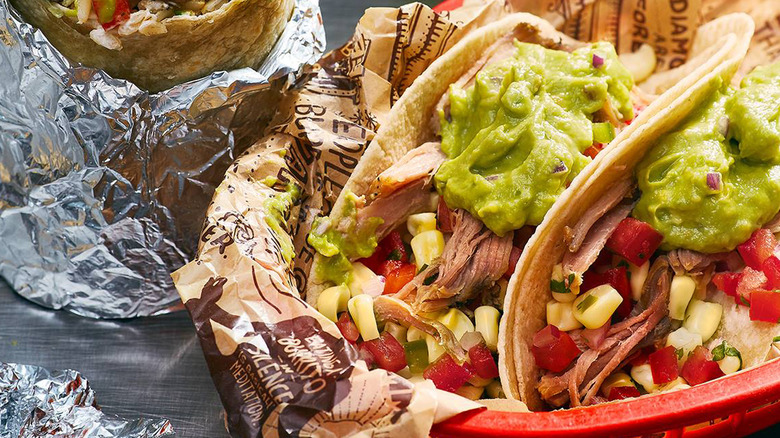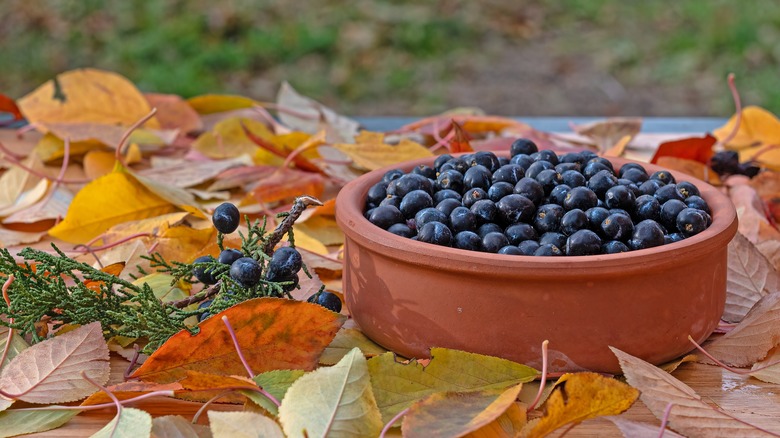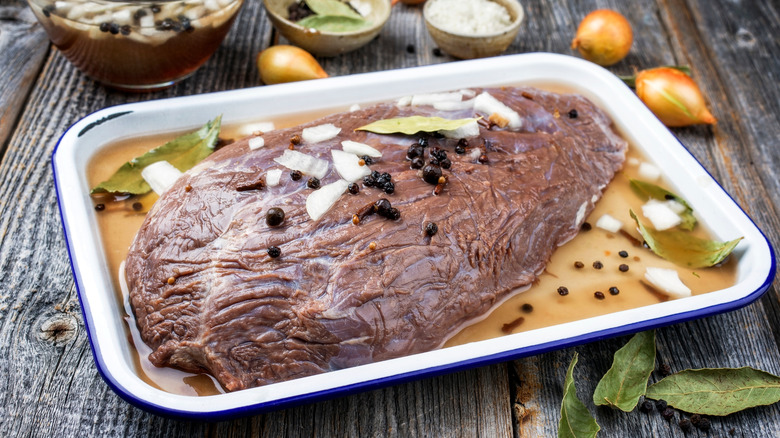The Unexpected Berry That's In Chipotle's Carnitas
Whether you get them in a burrito, taco, quesadilla, bowl, or salad, Chipotle's Mexican-style carnitas are delicious. The braised and hand-shredded pork is made with relatively few ingredients –one that isn't typically used in Mexican food. The surprising spice that flavors the dish is juniper berries.
Traditional carnitas are slow-cooked until the meat is tender, along with herbs, spices, and citrus — usually orange juice but sometimes lime. Chipotle takes an entirely different approach, opting instead to season its pork with a blend of aromatic juniper berries, black pepper, thyme, and bay leaves. The piney and pungent notes in juniper make it an unexpected yet excellent stand-in for acidic citrus.
Although juniper has a long history of culinary as well as medicinal uses, it is perhaps most well-known as the main ingredient that gives gin its herbal flavor. The name gin derives from the Dutch word "genever" and the French word "genièvre," both of which mean juniper. In fact, in order to be legally accepted as gin, the spirit's main flavor must be that of juniper.
As it turns out, that same botanical that gives gin its lemony and pine-like resinous taste goes perfectly with pork. This distinctly unique flavor is what makes Chipotle's carnitas, a name that translates to "little meats" in Spanish, one of its most popular protein options. Carnitas are the only pork item on the company's menu, and its only recipe made with juniper berries, which explains the flavor difference between Chipotle's barbacoa and carnitas.
What juniper berries taste like and how to use them
They're called berries and, when ripe, look similar to blueberries, but juniper berries aren't actually berries at all. Rather, they're seed cones, similar to pinecones — and, like pine trees, juniper (which can grow as a bush or a tree) is a conifer. Belonging to the Cypress family, there are at least 60 different kinds of juniper — though not every species is edible. The variety most frequently used for cooking and making gin is Juniperus communis, which can be found in a range of climates across the Northern Hemisphere.
While juniper's most prominent flavors are that of pine and citrus, the taste can also be described as simultaneously sweet and bitter, fruity, spicy, and peppery. It pairs well with similarly astringent rosemary, as well as thyme, shallots, garlic, caraway, black pepper, and foods that are pickled or made with vinegar.
The berries can be used fresh or dried, and crushing them will help bring out the most flavor. Coarsely grinding them with a mortar and pestle or spice grinder works well, but processing them into a fine powder can cause their flavor to become overwhelming. The fresh berries can be used in stews, marinades, infusions, brines, and stuffings. Dried juniper berries are outstanding in spice rubs for meat or tofu; a tasty blend can include any or all of the following: fennel seeds, red pepper flakes, onion powder, garlic powder, lemon pepper, rosemary, coriander, nutmeg, brown sugar, and salt.
Elevate roasted meat with the addition of juniper
Juniper is used in some Native American cooking where they are made into a seasoning, and calcium-rich ash from the plant's dried branches is used to soften corn. It is ideal, however, for use with meats, and Chipotle's carnitas are just one tasty example. Juniper goes with lamb, salmon, and especially elevates the flavor of game meats, including venison, mutton, rabbit, and duck. Try rubbing a juniper spice blend or crushed berries into your own meat recipes for a flavorful roast. In fact, the spice is key for making Oktoberfest-ready wild boar schweinebraten (aka roast pork).
Northern European cuisine is where you'll find juniper most commonly used in recipes, especially in Germany and Scandinavia. German dishes that take full advantage of juniper's benefits include sauerkraut and sauerbraten, which is a sweet and sour beef roast marinated in red wine, vinegar, and spices (predominantly juniper berries), and served with a thick gravy made from the braising liquid and ginger cookies.
Choucroute garnie is a specialty from Alsace, France, which shares a border with Germany, and the dish features German-style sauerkraut. The fermented cabbage is baked with potatoes, sausages, and various meats. In Jacques Pépin's version, the French chef uses kielbasa, pork ribs, ham, and hot dogs, along with a hefty amount of juniper berries. The Polish dish called bigos, also known as hunter's stew, is made with similar ingredients, plus the addition of mushrooms, and sometimes tomato paste, sauce, or beer.



